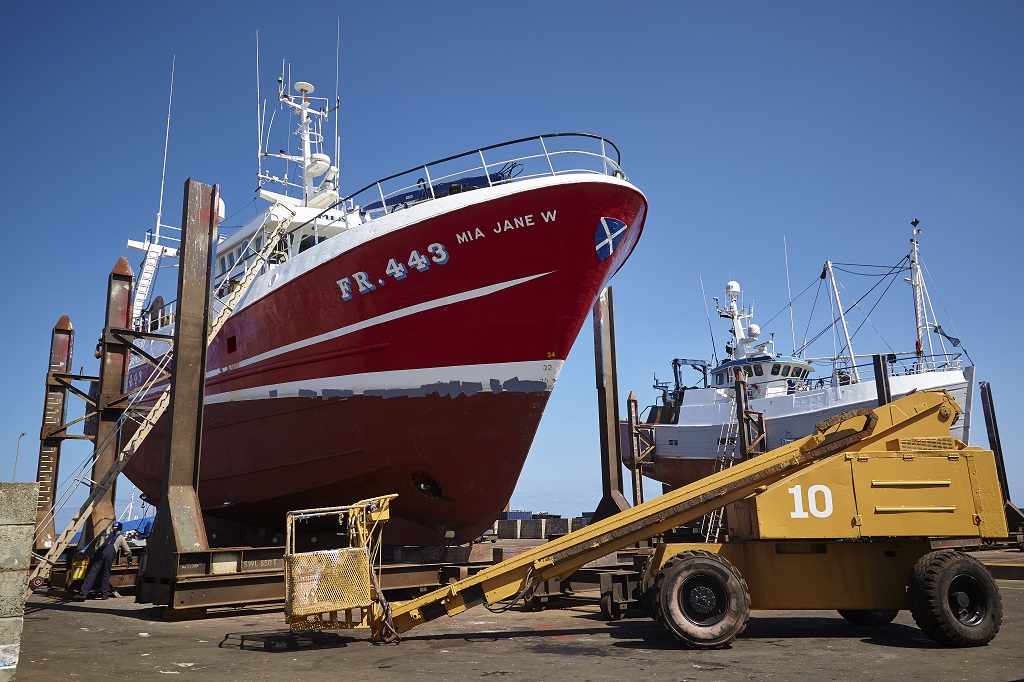
A tourist attraction that’s going to the wall
Having unintentionally created a colourful piece of art, W. Bruce Ship Painter’s workshop draws in tourists from far and wide.
‘Say cheese…’ shouted one painter when he spotted my camera, and another asked, ‘Fit are ye up tae then…?’ They soon realised that I was just another visitor drawn to Fraserburgh Harbour to take photos of the multicoloured wall at W. Bruce Ship Painter.
Adrian Buchan and his colleagues looked on with amused tolerance while I took some shots, then finished their tea break and headed back to work, across the road to the slip at Faithlie Basin.

The wall at W Bruce Ship Painters, Fraserburgh has become a tourist attraction (Photo: Mark Chalmers)
Aircraft carriers sail into dry dock when they need maintenance, but fishing boats are hauled out of the water on a hydraulic slipway. They sit on the dockside like beached whales while a team swarms over them, carrying brushes, rollers and giant cans of marine paint.
The painters scale ladders and rise up on cherry pickers, then begin to scrape, chip and burn off barnacles and rust.
Once the fishing boat’s hull has been cleaned up, the painters set to work with epoxy paint, a high-tech coating which is also used to protect the steelwork of North Sea oil platforms and the old Forth Bridge. Each fishing company has its own livery and the hulls and superstructures are painted in fawn, red, white, black or several shades of blue – but rarely green.
When piece time arrives, the ship painters troop back across the road and clean their brushes and rollers with a few strokes up and down the outside wall of W. Bruce Ship Painter’s paint store.

W Bruce Ship Painters at work (Photo: Mark Chalmers)
At first the wall was repainted once a year, in grey, for the annual harbour inspection. Since then, the paint has been allowed to build up into a spectrum of colours several inches thick. The firm’s owner, Fred Bruce, notes his amazement that the wall has become a kind of alternative tourist attraction.
W. Bruce Ship Painter was established in 1960 by the current proprietor’s father, William Buchan Bruce, and employs around 20 people, including Fred’s two sons. Many of the ship painters work full-time all year round, although the firm takes on a few seasonal staff to cover the busiest periods.
The paint store at Faithlie Harbour may be an unintentional work of art, yet its creators aren’t unskilled.
Some of the ship painters, such as Allan Murray, are talented signwriters, and fishing boat owners appreciate his hand-lettering technique in an era when that art has almost died out.
There’s an argument that not all buildings are architecture, and similarly not all paintings are artwork: it’s the intention behind them that matters. Architecture has its rules, whether dictating the golden ratio proportions of a classical colonnade, or the tell-tale features of Scots Baronial such as crow-stepped gables and pepperpot turrets.

A vessel awaits its new coat of paint (Photo: Mark Chalmers)
Likewise, artists often have a manifesto which drives their subject matter or technique. Perhaps we wouldn’t be so fascinated by W. Bruce’s wall if an artist had consciously created it to resemble one of Jackson Pollock’s ‘action paintings’.
Similarly, if an architect attempted to design a building which would evolve constantly, they would be accused of utter impracticality!
Instead, the wall has something in common with the murals that graffiti writers create using spray paint – but the viscous epoxy paint used here is very different to the runny cellulose paint which comes in aerosol cans.
As a result, W. Bruce Ship Painter’s wall has developed a rippled texture, like tree bark, and the paint store’s appearance changes regularly, like something organic. As a frequent visitor to Fraserburgh Harbour would notice, the ship painter’s wall is an eternal work in progress: a painting that never dries.
TAGS

